March and April were tough on the real estate market. But throughout May, as states have slowly started reopening, some of the tides have begun to shift. While it’s unlikely we’ll see the market rebound to its former highs anytime soon, there’s reason for hope.
Using Redfin’s COVID-19 Data Center tool, we can see some important real estate trends going into summer. Let’s look at some of the key stats and how they may affect you. We’ll be looking at all business markets in this article. (You can use the tool to get important information about your specific market, too.)
New listings are slowly creeping upward
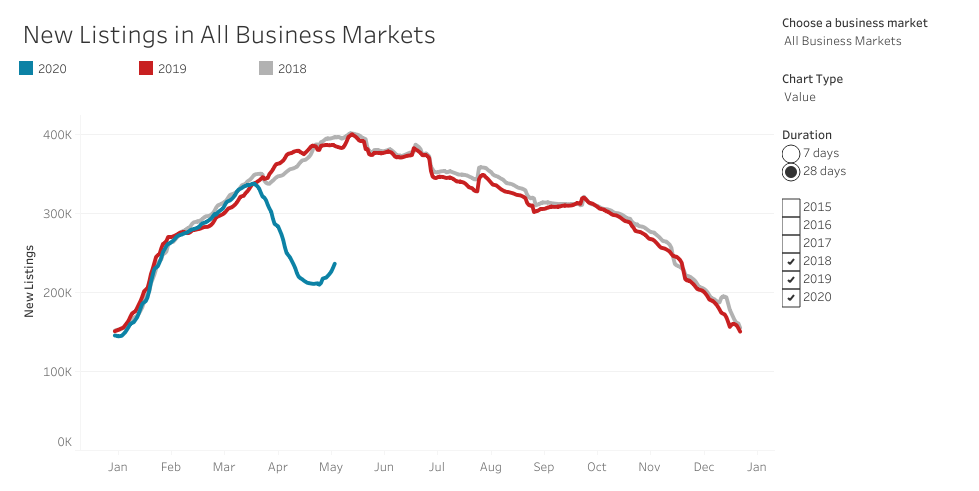
All charts from Redfin Data Center. 2018 data in gray, 2019 in red, 2020 in blue.
New-listing activity is an important indicator of business activity in real estate. Throughout March and April, you can see a huge decline in new listings as more stay-at-home orders went into full effect. At its lowest point, we saw a nearly 45% decrease in year-over-year new listings. But throughout May, that trend has started to reverse, with a modest but welcome increase in new listings.
Why does an increase in new listings matter?
New listings tend to drive inventory available for sale. Even before COVID-19, housing inventories were extremely low. As COVID-19 spread, fewer Sellers wanted to put their homes on the market. This pushed an already low inventory into record low territory.
While situations are still fluid, this small increase could be a sign that we could be past the lowest point of the new-listing problem in the real estate market. As more people are taking more precautions to reduce the spread of COVID-19, Sellers may be warming up again. More new listings can give agents more potential sales opportunities.
Additionally, this increase in listings may imply a small increase in confidence among Sellers. One of the biggest worries Sellers had was that COVID-19 would cause housing prices to crash. However, the data do not indicate that median prices fell due to COVID-19.
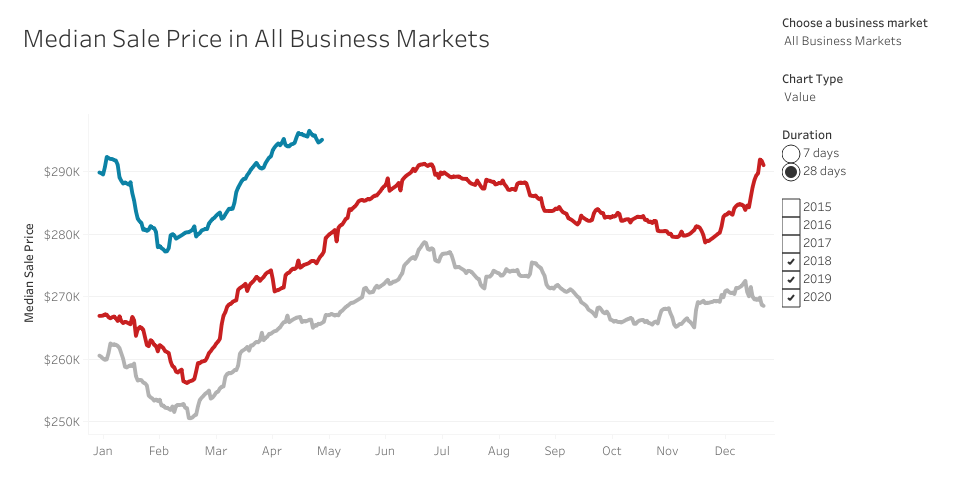
In fact, median prices rose, despite COVID-19. While the decrease in available listings may have played a role, the myth that home prices would crater doesn’t appear at all in the data. This is good news for Sellers.
Pending sales are also on the rise
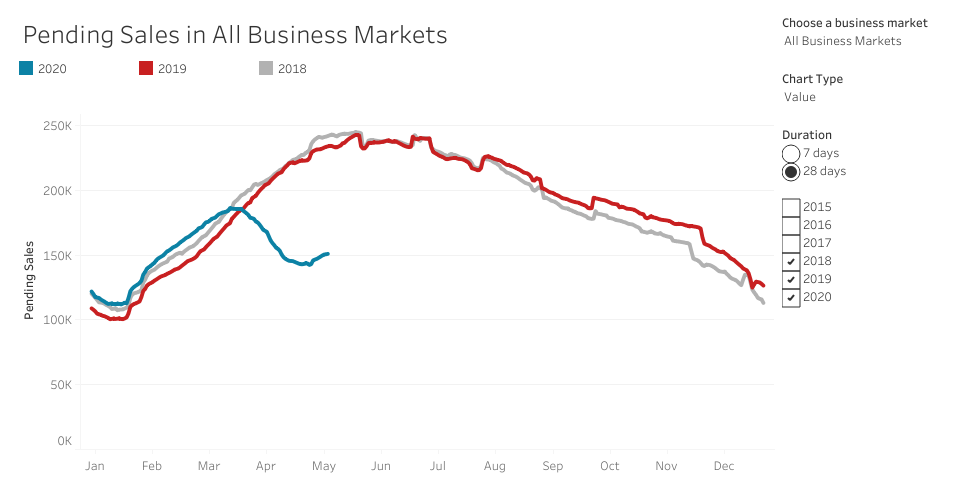
Prior to COVID-19, pending sales were on pace to outgain both 2018 and 2019’s rates throughout similar time frames. The decline in pending sales began at the end of March and then fell precipitously throughout April. But just like with new listings, the number of pending sales rose slightly throughout May. This could be a good sign for the real estate market.
Why does an increase in pending sales matter?
The increase in pending sales may imply a few things. Most obviously, it may imply an increase in confidence in Buyers. When COVID-19 first began having an effect in March, many people faced layoffs and furloughs. With some cities and states beginning to reopen, it may have given on-the-fence Buyers more confidence in their decision to pull the trigger on a home. Recently, mortgage applications for Buyers increased by 11%, according to CNBC.
The increase may also imply that there’s pent-up demand around the bend. Though it’s looking less likely that we’ll experience the V-shaped recovery some economists had hoped for, this increase could be the beginning of a slow, steady recovery. When you consider that 2020 had been outpacing pending-sales numbers before COVID-19, there’s lots of room for a market correction in the positive direction. Nothing is guaranteed during a pandemic, but these trends are a reason for optimism.
Delistings have fallen from their highs but are volatile
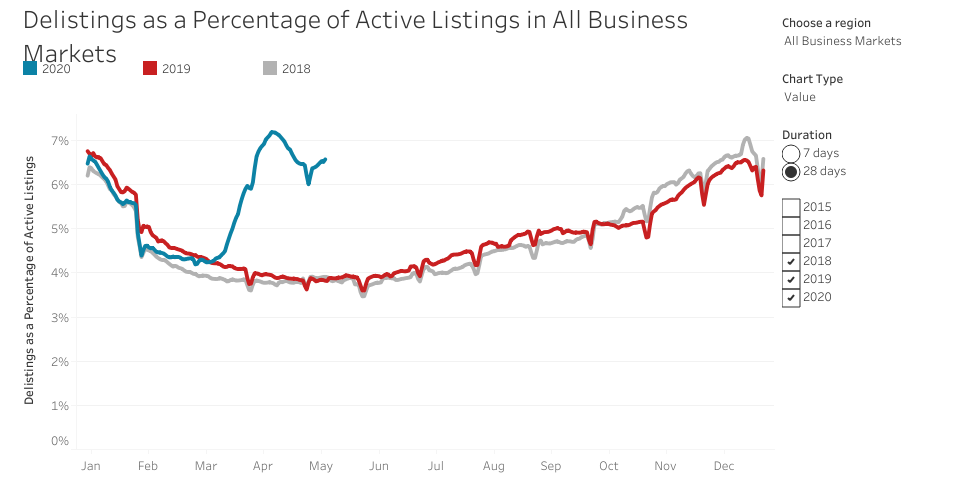
The percentage of delistings relative to active listings reached its highest point at the beginning of April. From about April 12 to April 29, delistings decreased. Since the 29th, delistings started to increase again, which may be a result of the volatility COVID-19 has created. However, you can see a similar, though less extreme, peak-and-valley trend in the 2018 and 2019 numbers around the end of April/beginning of May, too.
Why does this decrease matter?
Perhaps the scariest (professional) part of the nationwide COVID-19 shutdown for agents was the huge increase in delistings. As consumer confidence fell, more and more Sellers began to pull their homes off the market. This made low inventory problems even worse. But the overall decrease in delistings may be a more positive sign for the future.
The fact that the 2020 end-of-month trend generally mimicked trends over similar time frames in 2018 and 2019 may also be a sign of further normalization of the market, relatively speaking.
Total homes sold is on the uptick and may be primed to rise
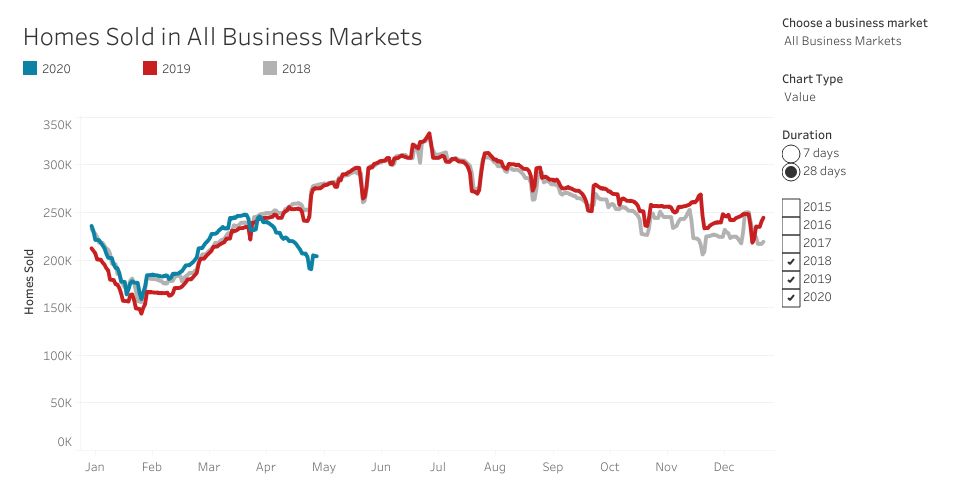
Obstacles obviously still exist for agents. But after a steady and uncharacteristic decrease in the number of homes sold throughout April, we’re noticing an uptick. It’s possible that we’ve hit the bottom in terms of a decline in houses sold. And recent trends look even more positive.
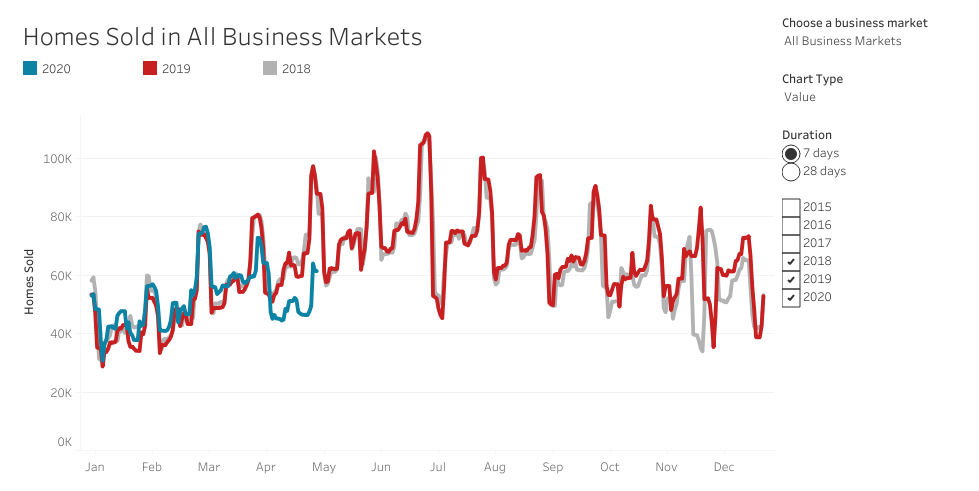
Digging more deeply into the last 7 days, we can see 2 positive signs. First, after the initial crash at the beginning of April, the total number of homes sold began increasing at the end of April, following a brief dip. Second, the trend line throughout April after the initial crash mimics activity from 2018 and 2019. Though the raw numbers are obviously lower in 2020, the trends are more normal than they may seem at first glance.
What to watch about homes sold going forward
Though we likely aren’t out of the woods yet, we may be getting closer. In 2018 and 2019, the number of homes sold skyrocketed at the beginning of May. Though it’s not likely that 2020 will reach those highs, it’s possible to see a spike similar to the ones we saw over the last 2 years around this time frame. This may reinforce the theory that COVID-19 is simply a black swan, rather than a systemic problem like the 2008 crash.
2-10 HBW wants to help you succeed
Whether the market is great or not so great, 2-10 Home Buyers Warranty (2-10 HBW) wants to help you succeed as an agent. We always offer comprehensive home warranty coverage for Buyers and Sellers so if a major system or appliance breaks down, it won’t derail your sale. You can also find tips and guides to help you market your homes during COVID-19, such as our “5 Steps to Successful Virtual Home Tours” article.
Things may be starting to look up for the real estate market. 2-10 HBW wants to support you as we all begin trying to get back to normal.
2-10 HBW offers comprehensive systems and appliances home warranties to help protect your clients from unexpected repair and replacement costs. Contact us to learn more.








